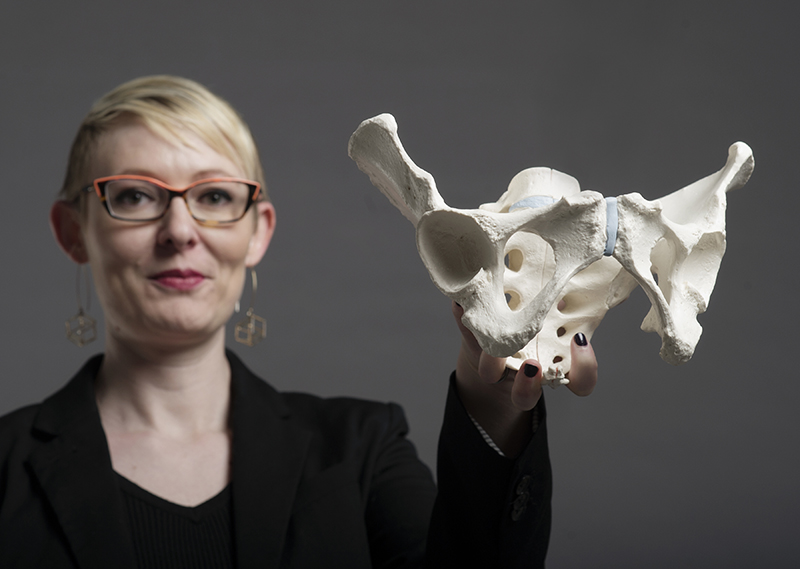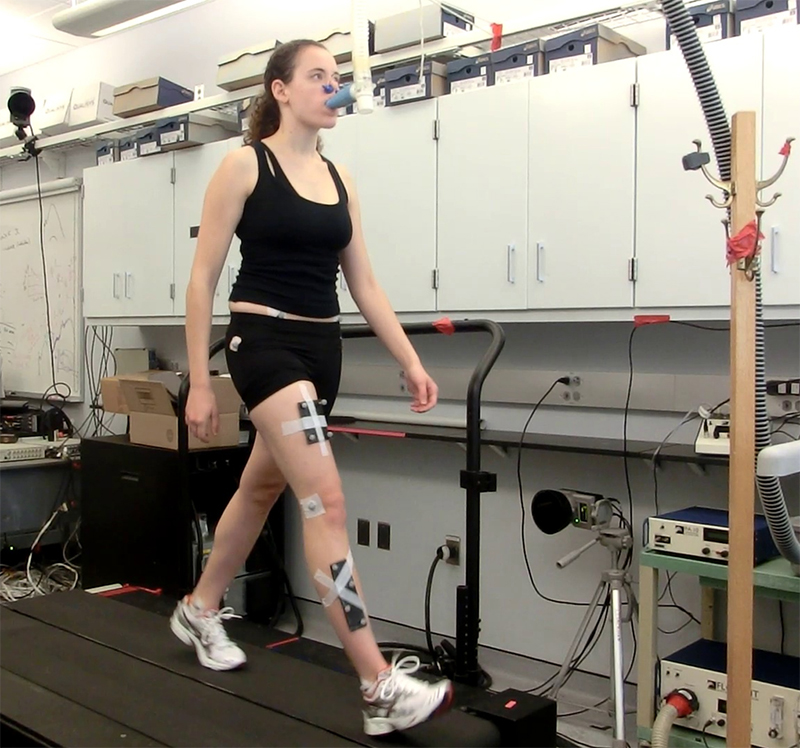In Defense of Wide Hips
Just because you have a wide pelvis doesn’t mean you can’t be an efficient runner—and walker—biological anthropologist shows

Kristi Lewton, assistant professor in the anatomy and neurobiology department at BU School of Medicine. Photo by Jackie Ricciardi
What can you learn from a pelvis? Among the qualities that make humans unique are two physical features: our way of walking and running upright on two legs, and our newborn babies’ very large heads. Those two traits of humanity meet at the pelvis, a set of bones that includes the ilium, ischium, pubis, and sacrum.
For more than 50 years, anthropologists thought that the human pelvis was shaped by an evolutionary tug-of-war between the competing demands of bipedalism and childbirth. Now, a team of scientists that includes Kristi Lewton, an assistant professor in the department of anatomy and neurobiology at Boston University School of Medicine, and colleagues at Harvard University, Hunter College and Washington University, St. Louis, has shown that this so-called “obstetric dilemma” might not be a dilemma at all. The study’s first author is Anna Warrener, a postdoctoral fellow at Harvard working in the lab of Daniel Lieberman, the Edwin M. Lerner II Professor of Biological Sciences. The study grew out of research Warrener conducted as part of her Ph.D. at Washington University, which she completed under the supervision of Herman Pontzer, now a professor of anthropology at Hunter.
Humans give birth to very large (“ginormous!”) newborns, says Lewton. While chimps and other nonhuman primate babies emerge from the birth canal with room to spare, human infants must perform a complicated series of rotations to make their way into the world, and the pelvic opening is just barely big enough. If something goes wrong, the lives of both mother and baby are at risk. So, why hasn’t the human body evolved a wider pelvis? Anthropologists have long believed that an evolutionary trade-off was at work; they assumed that a wide pelvis was “bad for bipedalism,” says Lewton. Yet, until now, no one had rigorously tested this assumption.

Lewton and her colleagues set out to discover whether wide hips really do make running and walking less efficient. They recruited 38 undergraduates, including both men and women, and had them walk and run on a treadmill while gauging how hard they were working by measuring their oxygen consumption. While the participants exercised, their motion was tracked by eight cameras trained on infrared markers attached to the participants’ hips, knees, ankles, thighs, and shanks. Lewton and her colleagues estimated the subjects’ hip width using the results from the infrared trackers, and later combined their data with results from a Washington University in St. Louis research team that used MRI to get a direct measure of hip width. (True hip width is defined as the distance between the hip joints, points out Lewton, and is different from what you would measure with a tailor’s tape.)
If the basic assumptions of the obstetric dilemma are right, says Lewton, participants with wider hips should run and walk less efficiently than those with narrow ones. But that wasn’t what Lewton and her team found. Instead, they found no connection at all between hip width and efficiency: wide-hipped runners moved just as well as their narrow-hipped peers. Lewton and her colleagues published their results in March 2015 in the online journal PLOS ONE. The work was supported by grants from the National Science Foundation and The Leakey Foundation.
“This ‘trade-off’ between hips wide enough for a big baby and small enough for efficient locomotion does not seem to occur,” says Lewton. “That means that we have to rewrite all of the anthropology textbooks! Even outside of textbooks, the general public thinks that if your hips are wide, you’re a bad biped, and that does not seem to be the case.”

That should make bipeds of all shapes and sizes feel good. But it leaves a question: If the demands of locomotion aren’t holding them back, why haven’t human hips gotten wider over generations of evolution—and why hasn’t childbirth gotten any easier? Perhaps a third, still-unknown evolutionary force is at work. Or maybe, Lewton suggests, human childbirth hasn’t always been so hard.
It’s almost impossible for paleoanthropologists to know what childbirth was like hundreds of thousands or millions of years ago, says Lewton. Though a handful of fossilized adult skeletons tell one side of the story, there is no such record for newborn babies, whose soft skeletons aren’t well preserved by fossilization. “It’s a little difficult to infer whether this mismatch between fetal size and pelvic size was actually a problem in the past,” says Lewton. “We’re missing half the equation.”
Some researchers believe a dramatic change happened about 10,000 years ago, when Neolithic humans made the switch from foraging to farming. Comparing skeletons from before and after this transition, anthropologists have found that the bones and teeth of people who lived on an agricultural diet, with lots of grain and relatively little protein, were relatively weak. Anthropologists also think that widespread vitamin D deficiencies appeared around this time, as recorded in malformations of the pelvic bones. If babies got dramatically bigger at the time of this agricultural transition, we might not yet see the impact of evolution on the body.
To understand the forces that have shaped the pelvis over time, Lewton is also looking to our primate relatives, from tiny pygmy marmosets all the way up to hulking 220-pound gorillas. Over the course of half a year, Lewton traveled to seven museums around the world, examining skeletons from 800 individual animals representing 40 different primate species. Her collection included four different “locomotor groups”: humans; animals that spend most of their time in trees; “terrestrial quadrupeds” that walk on four legs on the ground; and, most dramatically, “vertical clingers and leapers,” which generate huge propulsive forces as they perform their acrobatics.

Using a simple mechanical model in which the bones of the pelvis are treated as rigid levers, Lewton made a series of predictions about how the pelvic bones should vary across the four groups. But of the nine different features she analyzed, only two—the height and strength of the lower part of the ilium—matched her predictions. “What this suggests to me is that the model that we derived these predictions from is not quite right,” says Lewton. She is now developing more detailed models of the pelvis that will enable her to gauge directly the stresses and strains on the bones.
The research is all part of Lewton’s greater goal: to bring fossils “back to life” by illuminating the links between how animals are built and how they behave. By studying these connections in living creatures, says Lewton, “we can generate much better hypotheses about how anatomy is related to function,” and we can begin to imagine, with fidelity, the full and animated lives lived by the creatures to whom those fossilized bones once belonged.

“I’ve always been interested in fossils, ever since I was a tiny, tiny kid,” says Lewton. When she was just five years old, she started volunteering once a week at the San Diego Natural History Museum. “We’d go behind the scenes and work with one of the curators, and we’d clean fossils—little tiny shells and things—with picks and brushes,” Lewton recalls. “My mother thought it was very tedious, and she kept thinking I would get bored of it—but I never got bored of it.” By the time she was nine, Lewton had graduated from shells to dinosaur bones, and spent days at a time scouring a Montana quarry for fossils as part of a children’s program sponsored by the Museum of the Rockies. In high school, Lewton began to seek a deeper human connection to her work. She put down the dinos and took up paleoanthropology, the study of human ancestors.
All of which brought her to the pelvis: “I’ve always been interested in the origins of bipedalism: Why did we become bipedal, and when did we become bipedal?” Because the pelvis connects the legs to the rest of the body and transmits all the forces encountered during locomotion, “this seems like a structure that could potentially be very informative for figuring out these relationships between anatomy and function and, ultimately, reconstructing behavior of the fossil record.”
So, what can you learn from a pelvis? If you’re Kristi Lewton, you just might be able to learn something new about what makes us human.
Comments & Discussion
Boston University moderates comments to facilitate an informed, substantive, civil conversation. Abusive, profane, self-promotional, misleading, incoherent or off-topic comments will be rejected. Moderators are staffed during regular business hours (EST) and can only accept comments written in English. Statistics or facts must include a citation or a link to the citation.